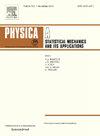A stochastic car-following model in the framework of Kerner’s three-phase traffic theory
IF 2.8
3区 物理与天体物理
Q2 PHYSICS, MULTIDISCIPLINARY
Physica A: Statistical Mechanics and its Applications
Pub Date : 2025-07-05
DOI:10.1016/j.physa.2025.130798
引用次数: 0
Abstract
The relationship between the mechanisms of traffic congestion and stochasticity remains a critical issue that requires further investigation. This paper aims to reveal the stochastic characteristics of driving behavior to explore the intrinsic mechanisms of traffic flow instability and capture the dynamic features of congestion patterns, further enhancing the reproduction of the effects of stochasticity on traffic oscillations. Based on this, a Multi-Factor Stochastic Traffic Flow Model (MSTF) is proposed from a microscopic perspective, incorporating conditions such as safe speed, movable distance, desired distance, and stochastic slow-down probability. Simulation results show that the model can reproduce all traffic flow patterns under various boundary conditions, including Local Synchronous Pattern (LSP), Widening Synchronous Pattern (WSP), Moving Synchronous Pattern (MSP), Dissolving General Pattern (DGP), and General Pattern (GP). Moreover, when in a critical state, the model accurately reproduces traffic flow metastable state, spatio-temporal patterns, and phase transitions. Calibration and validation results indicate that the model effectively simulates the actual phenomenon of spacing fluctuations between following vehicles (with a minimum RMSPE of less than 0.05) and accurately reproduces the concave growth pattern of speed oscillations in car-following platoons. The research outcomes further highlight, both theoretically and numerically, the influence of stochastic factors on traffic flow stability. These findings provide valuable insights for the development of stochastic car-following models capable of accurately reproducing observed traffic congestion patterns.
Kerner三相交通理论框架下的随机车辆跟随模型
交通拥堵机制与随机性之间的关系仍然是一个需要进一步研究的关键问题。本文旨在揭示驾驶行为的随机特征,探索交通流不稳定的内在机制,捕捉拥堵模式的动态特征,进一步增强随机性对交通振荡效应的再现。在此基础上,从微观角度考虑安全速度、可移动距离、期望距离和随机减速概率等条件,提出了多因素随机交通流模型(MSTF)。仿真结果表明,该模型能够再现各种边界条件下的所有交通流模式,包括本地同步模式(LSP)、扩宽同步模式(WSP)、移动同步模式(MSP)、溶解通用模式(DGP)和通用模式(GP)。此外,当处于临界状态时,该模型能准确地再现交通流亚稳态、时空格局和相变。标定和验证结果表明,该模型有效地模拟了跟随车辆间距波动的实际现象(最小RMSPE小于0.05),准确再现了跟随车辆队列速度波动的凹形增长模式。研究结果从理论上和数值上进一步突出了随机因素对交通流稳定性的影响。这些发现为开发能够准确再现观察到的交通拥堵模式的随机车辆跟随模型提供了有价值的见解。
本文章由计算机程序翻译,如有差异,请以英文原文为准。
求助全文
约1分钟内获得全文
求助全文
来源期刊
CiteScore
7.20
自引率
9.10%
发文量
852
审稿时长
6.6 months
期刊介绍:
Physica A: Statistical Mechanics and its Applications
Recognized by the European Physical Society
Physica A publishes research in the field of statistical mechanics and its applications.
Statistical mechanics sets out to explain the behaviour of macroscopic systems by studying the statistical properties of their microscopic constituents.
Applications of the techniques of statistical mechanics are widespread, and include: applications to physical systems such as solids, liquids and gases; applications to chemical and biological systems (colloids, interfaces, complex fluids, polymers and biopolymers, cell physics); and other interdisciplinary applications to for instance biological, economical and sociological systems.

 求助内容:
求助内容: 应助结果提醒方式:
应助结果提醒方式:


